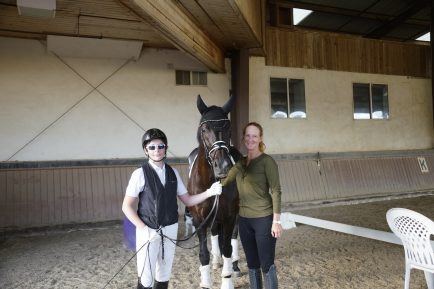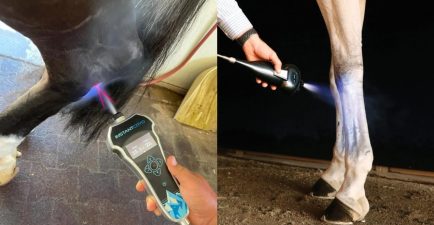In this article, we will be concentrating on the basic concept of ‘throughness’, and establishing this concept in the early stages of training.
Firstly, the aims and objectives of the Preliminary level are to get the horses willing to work forward in all paces, using all muscles in their body in a loose and elastic way. To learn submission and obedience, to react to the rider’s instructions throughout the basic transitions of walk, trot and canter. The horse should be steady in its outline and show an active but consistent rhythm throughout the dressage test. The obedience of the horse is tested by the individual exercises and different lines ridden within the four Preliminary tests, however accuracy alone is not the priority of the level. It must be remembered that before accuracy, comes the overall quality of the basic working paces.
I consider Preliminary to be the first level of a dressage horses’ competitive career and the beginning of its basic training. There are a few basic rules that you must establish in these early stages of training and the first that we will cover in this series of training articles is that of ‘throughness’.
Throughness is an intangible concept in dressage training which describes a horse moving freely through its entire body, with no tension or resistance. The horse must be in front of the riders’ leg, having a forward desire in all paces together with a submissive contact, moving through the reins. It is intangible because you can never have your horse too through, and is something that good dressage riders are always seeking in their quest for professional excellence.
When beginning your preliminary training and then what would be the beginning of teaching your horse to go through, you firstly must train your horse to react forward from your driving (leg) aids and to cover ground in each stride of canter or each step of trot or walk. To get your horse reactive to your leg aids, you must have a clear and uncomplicated sequence of aids. To do this, you should firstly touch your horse softly with your inner leg positioned on the girth as your primary aid. If the horse shows no reaction, then straight after you should use a stronger leg, which may include a little use of the spur again on the girth. If again no reaction, then you must use maximum effect from your spur, with the full intention of feeling an urgent forward reaction from the horse.
Some people will give a full power kick at this point, but I find that a fast scratch with the spur is less offensive to the horse and more effective. It’s more like a fast tickle that surprises them but let’s face it, you are trying to create a reaction from an agitation, so whatever way you can create the reaction is ok, as long as it is quick and effective and gets the horse forward. Some people will use the whip but for me personally I will only use the whip as a very last resort with my preference to get the reaction and understanding to react off my leg.
At any stage through this sequence if the horse does react urgently forward, you should relax your leg as a reward and on some occasions offer voice praise. This is to make the correct response of the horse more clearly understood by the horse. Now you show me a text book that will tell you to do this, but in the real world of training dressage horses, it has to be like this. You have to be consequent in what you expect from your horse, and then reward them by leaving them alone.
Once you have a reliable reaction to your driving aids and a horse which is forward thinking, then you should work on teaching your horse to be submissive to the contact. This means that every time you put pressure into the reins, the horse should give a softening reaction. It doesn’t mean that they should drop the bit and become empty, but they should give in the poll and come rounder in the frame. This applies also when asking for flexion or bend. The horse should show submission of the jaw and neck giving flexion and bend into the direction you wish, whilst staying connected into both reins.
You can start this in halt by standing and asking your horse to give into both reins, coming rounder when you ask. Then, when they can reliably give you the correct response, ask for flexion and bend of the neck whilst still keeping a steady connection into both reins. Once you get consistent responses, then try this in walk, trot and canter, on straight lines and 20m circles.
The sequence of your rein aids is similar to that of your leg aids. First ask with a light rein aid, then a firmer aid if you don’t get a reaction. If your horse is uncomfortably strong and not reacting to your request, sometimes it is best to come back to a gait where you know you will get a response, e.g. from canter to trot or trot to walk or sometimes even halt. Once you get the response you were after, then reward by softening the rein contact, and/or giving voice praise. Then take it back to the gait you were in originally and try again. Remember, consistency is one of the most important things in training a dressage horse so be consistent in your requests and keep returning to the point of resistance and see if you can get through it.
I am often asked, what is the perfect contact? My response is always the same. In my opinion the perfect contact is that which fits both the horse and the rider and does not exceed eithers level of comfort. The feeling from the saddle and the appearance from the ground should be that the horses’ hind legs are connected to its poll. A horse which is too light in the hand will often be disconnected through its body, holding some tension through its neck or back, whilst a horse which is too strong will be fixed in the jaw and poll and will be stiff in the neck and body.
Remember to be through, your horse must feel connected but supple, in front of your leg with no resistance in its body. This feeling is imperative when you are establishing the basic way of going in a preliminary horse.
Original article: Equestrian Life – How do you achieve ‘throughness’ in early training?

























